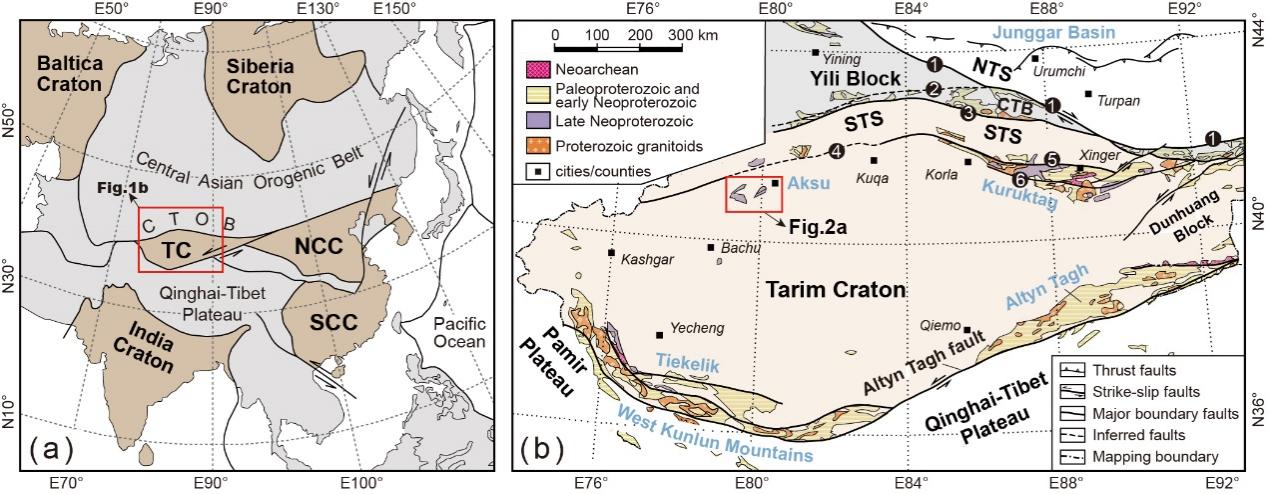Editor: 邵丹蕾 Author: Wu Hong-Xiang,Zhang Feng-Qi,Chen Han-Lin Time: 2022-03-29 Number of visits :338
The Neoproterozoic was a very important period in the global tectonic evolution, during which the assembly and breakup of the Supercontinent Rodinia occurred. Central Asian blocks such as the Tarim Craton, Yili, and Central Tianshan preserved rich geological records such as Proterozoic stratigraphy, structural deformation, metamorphism and magmatism (Figure 1). Domestic scholars have also noticed their possible tectonic affinity with the evolution of the Rodinia. Since then, a lot of research work has been carried out, and fruitful results have been obtained, which greatly promoted our understanding of the Precambrian geology in this area. However, the Neoproterozoic tectonic setting of the Tarim and its tectonic location in the reconstruction of the supercontinent are still hotly debated.

Figure 1. (a) Tectonic framework of Eurasia showing the major cratons (modified after Ge et al., 2014) and the location of the TC: Tarim Craton, NCC: North China Craton, and SCC: South China Craton. Note the position of Chinese Tianshan Orogenic Belt (CTOB). (b) Simplified geological map of Tarim Craton and CTOB, showing the main Precambrian rock units in these blocks (modified after Ge et al., 2014, 2016). STS: South Tianshan, CTB: Central Tianshan, and NTS: North Tianshan. Block unit divisions are after lithospheric faults: ① North Tianshan fault; ② North Nalati fault; ③South Nalati fault; ④North Tarim fault; ⑤ Xinger fault; ⑥ Xingdi fault. (after Wu HX et al., 2022)
The basin structure research team of the Zhejiang University has systematically summarized the research progress of Neoproterozoic strata, magmatism, metamorphism, basin sedimentary filling and detrital provenance in the northern margin of the Tarim Craton and Central Tianshan, Yili and other blocks. Based on this work, they have published a review article on the international journal of Earth-Science Reviews (Wu HX et al., 2022), and proposed a new model of "collision orogeny" between the Tarim and the Yili-Central Tianshan (YCTB) during the mid-Neoproterozoic. Some conclusions were drawn as following (Figure 2):
(1)The northern margin of the Tarim Craton in the early Neoproterozoic was a passive continental margin, while the southern YCTB was an active continental margin, and an unknown oceanic basin developed between the two blocks. The unknown oceanic basin only subducted toward YCTB.
(2)The closure of this oceanic basin in the mid-Neoproterozoic (~835 Ma) led to the collision of the Tarim and the YCTB, during which a peripheral foreland basin may have developed on the northern margin of the Tarim. With the ongoing orogeny, the accretionary complexes of the southern margin of the YCTB as well as the foreland basin strata were finally involved in the orogeny and underwent different degrees of metamorphism during the period of 830-790 Ma.
(3) Neoproterozoic orogeny ceased at ~780 Ma, and then rapidly shifted to tectonic extension, and developed a number of 780-760 Ma bimodal-basic dykes; during the period of 760-610 Ma, possibly also affected by mantle plume activities, the continuous tectonic extension occurred and was featured by multi-stage rifting and episodes of volcanic eruption and A-type granite intrusion.
(4) Around 600 Ma, the new ocean basin between the Tarim block and the YCTB opened again, entering a new passive continental margin, and the two blocks became independent blocks again.
Therefore, this paper argues that the mid-Neoproterozoic orogeny on the northern margin of the Tarim Craton was a continental collision orogeny with the YCTB, rather than a subduction-accretionary orogeny as previously thought. It may have recorded the final assembly event within the Rodinia supercontinent, after which the supercontinent entered into a rifting-drifting phase.

Figure 2 The evolution process of the assmbly-collision-breakup of the northern margin of the Tarim Craton and YCTB (after Wu HX et al., 2022)
The first author of this paper, Wu Hong-Xiang, is a doctoral student at the School of Earth Sciences, Zhejiang University. Professor Zhang Feng-Qi and Professor Chen Han-Lin of Zhejiang University are the corresponding authors. This research was funded by the National Natural Science Foundation of China (Grant No. 42077223), the Basic Science Centre Program for Multiphase Media Evolution in Hypergravity of the National Natural Science Foundation of China (No. 51988101), the National Key Research and Development Program of China (grant No. 2016YFC0601004) and the National Science and Technology Major Project Fund of China (grant No. 2017ZX05008-001).
Article information: Wu, H.X., Zhang, F.Q., Dilek, Y., Chen, H.L., Wang, C.Y., Lin, X.B., Cheng, X.G., Zhu, K.Y., 2022. Mid–Neoproterozoic collision of the Tarim Craton with the Yili–Central Tianshan Block towards the final assembly of Supercontinent Rodinia: A new model. Earth-Science Reviews, 228, 103989.
